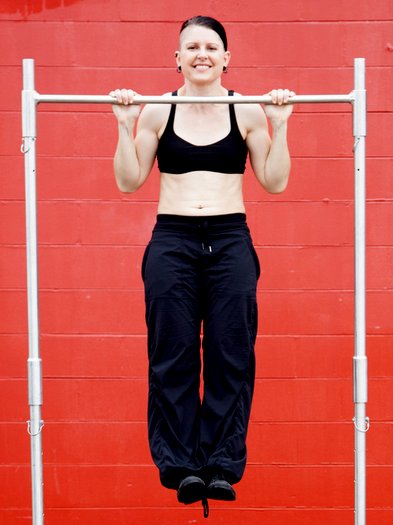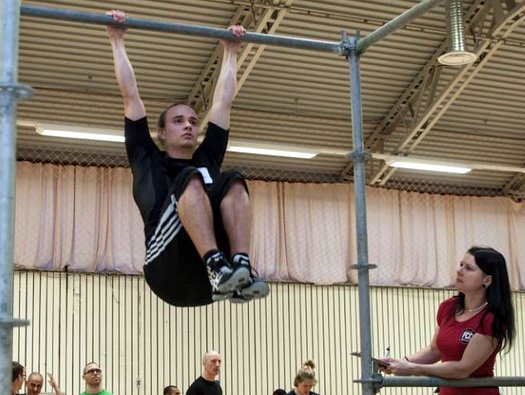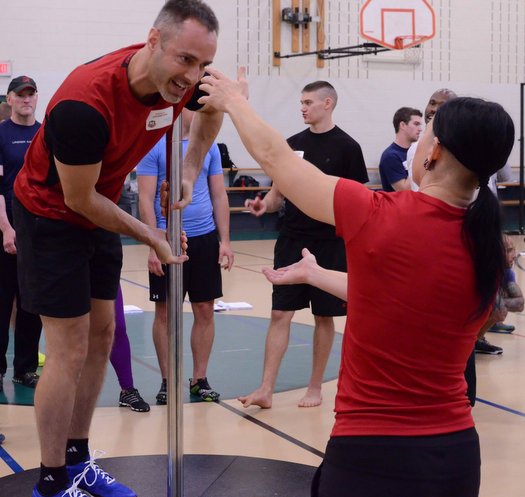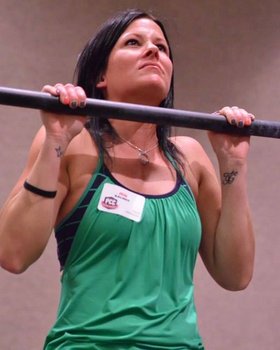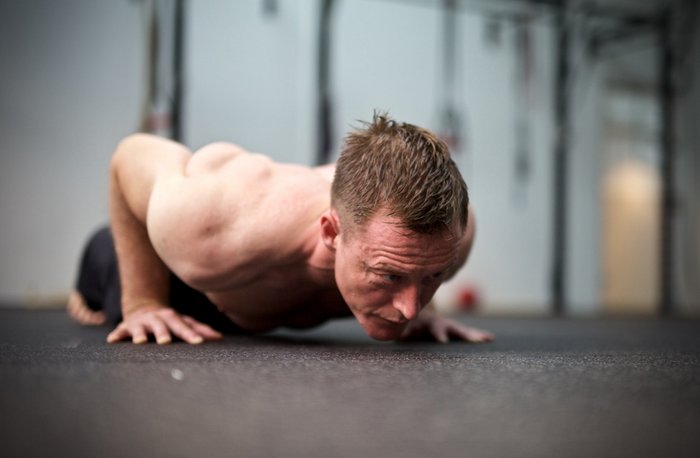
As I prepared to attend the recent PCC Workshop in New York City, I began using a system inspired by the Swedish running technique known as “Fartlek Training”, a form of interval training where you let the terrain and your mood direct the speed and intensity of your running.
The name “Fartlek” translates to “Speed Play” in English and “play” is a very accurate word to describe it, as it’s close to the way a kid moves just for enjoyment or exploration. It is running by feel, running by inspiration.
I decided to name my system “Replek” as it is a similar method to Fartlek, except instead of playing with your speed, you play with your reps.
The plan is well suited to the PCC Century Test as well as getting the most out of the workshop weekend. In addition to positioning you to pass the Century, it also adapts your body to handle a high volume of calisthenics over several days.
Replek is nice and forgiving. It takes your daily stresses, aches and pains into consideration. Like a sly lover, this plan lets you believe that the initiative and follow through are all yours, that there is no plan, really, no string-pulling, no forcing. It’s all about you and what you feel like doing.
You stay within your comfort-zone, don’t do anything you don’t feel like doing, and yet results appear and motivation grows. Your comfort zone will expand from the inside out, and what seemed like too much work a while ago just isn’t anymore. You didn’t break any barriers. The barriers just moved.
There is a time for working through adversity, facing your demons, finishing unbearable workouts and so on. To be able to fight through discomfort is invaluable. But so is getting results without suffering, and learning how to productively back off at the right moment.
Replek for PCC is done this way: You pick exercises or chains that you want to work on (pull-ups, push-ups, squats, leg raises, bridges, etc.), then you start playing a game with yourself.
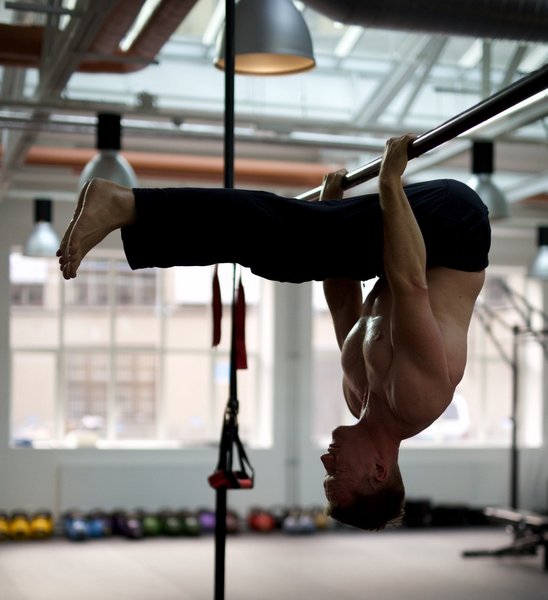
Here are the rules of the game:
Wherever, Whenever
It is up to you if you want to do all your reps in a condensed workout, spread them throughout the day or do some combination of the two. I recommend that you mix all these modes. After a while, you won’t care, because you’ll have grasped the essence of the program, which is sneaking the reps in whenever possible.
Never to Failure
That means you must always stop at least one rep before your failed rep. Most sets should stay way clear of that. The only exception to this is when you on occasion, do some version of the Century Test.
Avoid Punishment
As this program is based on positive reinforcement, it is your job and responsibility to stay away from the punishment of injury, failure, getting overly exhausted or negative self talk (or negative self talk about you giving yourself negative self talk). Stay away from the drama. Stay away from the heroism and struggle. Observe your form, do your reps, log your sets, stay fresh.
Keep a Log
You always want to capture exactly which exercise/variation you do, your number of reps and sets and the daily total of any given exercise. The log is the most important tool of this method. The log is also crucial in keeping your motivational fire burning (pun not intended, but gratefully received). In the beginning you might actually have to force yourself to log. In a short while, however, you will have a deep desire to do so.
Just write the date and the reps for each exercise. You don’t need to bother with noting rest periods and so on, but can feel free to keep additional notes if you find it helpful. But we don’t want to punish you for training by forcing you to write an essay, do we?
This was my log entry for the 16th of May, this year:
BW squat: 50
Push-ups: 20/22/6/20/24/21/21/20/22/23/15 – 224
Shoulders feeling much better than yesterday
Wheel roll-out: 10/10/4 – 24
Pull-up: 9/6/9/7/10/ 10 (chin up)/5/7 – 63
Pistol:
R: 4/3 – 7
L: 2/2/2 – 6
Push-ups – one hand on basketball
V: 4/6
H: 4/6
Bottom position of pistol: 50 sec/50 sec
Short bridge: 1 min
Crow (sec): 10/20/20
Squat bottom pos: 5 min
Couch stretch: 4 min
Another day looks like this:
Pull up: 1/5/7/13 – 26
That was all the training I did that day. Still, getting the 13th rep in was very nice! It is not my historical best in that department, but the best I had done for a long time.
Personal Records
One of the great features of this program is that you can experience personal records on a daily basis. Your goal is to increase the number of reps during a set as well as the total number of reps of any given exercise during a day. Say your first day you do four sets of push ups: 5/10/15/7 = 37. The next day you do 4/7/16/10/ 3 = 40. Boom! You double-PR’d on the push up! Whenever you PR underline the number or write in bold as I did here, so it is always easy to track the history of PRs, and check your current status. By the way, the PRs we are talking about are the ones within this program. Forget about past glory and previous heights of achievement. Focus on the present.
Less Structure
Some days you’ll have the time or inspiration to collect your reps within the frame of a more conventional workout. Structure those sessions however you like, and feel free to change trajectory mid-flight. Concentrate on one exercise at a time, or do super-sets, tri-sets or circuits. You are guaranteed to stumble upon combos or sequences that work really well for you, and that belong in your arsenal of go-to-workouts. You will also experience that there is drive in open-endedness, especially given that you have your previous PRs to relate to.
Test the Waters
Always be extra careful with the first few sets. Hone in on the perfect rhythm, and at the same time actively search for any discomfort or pain. Go slow. Think of these reps as screening. Maintain tension in all the right places. Does this feel like a good day for squats / push ups / L-sits? If so, go for it! If not, it may be best to back off and try something else. Other times an exercise will feel much better a couple of sets in, so don’t be to quick to abort, but also keep the “ live to fight another day” mentality at heart. If it is not a great day for squats, it might be an excellent day for pull-ups.
Stay Modest
Sometimes you will feel like a star. You become the exercise, you feel power running effortlessly through your whole body as you perform perfect reps. This is when you can astonish yourself with a crushing PR. Most of the time, though, stick to modest ones. Many small PRs are preferable to a few big ones. Try to not get more than one PR per exercise each day, and don’t PR on the same exercise two days in a row. Remember that the PR is the reward that will keep you going. Spread them out. The smaller the increments, the more PRs you can enjoy. You are setting yourself up for a very productive schedule of reinforcement, and are safeguarding against overuse.
Whenever you PR – back off, and then see what you feel like the next day. The next day you might do a very low total number of reps in that exercise, just to recover, or maybe stay away from it completely. If you feel like too much time has passed since your last PR, then do a volume PR – these are always accessible. You can always get in one more rep during a day. Just make sure you don’t sacrifice your form just to get an extra rep. This is why you can rest as long as you need between sets.
Maintain High Standards
The aforementioned point taken into consideration, a standard to reach for might still be a good idea, as long as you don’t rush to get there. If you are preparing for the PCC, then passing the Century Test is an obvious goal. 40 squats, 30 push ups, 20 knee raises and 10 pull ups should feel very comfortable on their own, meaning you should be able to do 60 squats, 45 push ups, 30 knee raises and closer to 15 pull ups.
Prioritize
The last pull-up is where many Century hopefuls fail. Make the pull-up and pull-up related work the centerpiece of your efforts. The push up is also a natural focal point – follow the progressions in Convict Conditioning or Pushing The Limits!
That’s it! Now all you have to do is start somewhere, preferably well within your comfort zone, and then let the Replek catch up with you and unfold. Enjoy the journey, have fun, and get strong!
****
Karl Kristian Indreeide, PCC, is part owner of Gym Ila in Oslo, Norway, where he teaches kettlebell and bodyweight training. He also runs HAVA-Instituttet, which provides consultation, seminars and full-scale health and social services.
